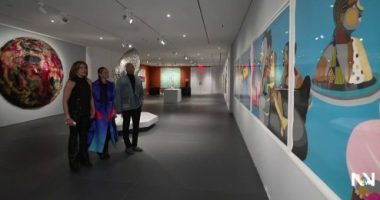
HONG KONG — The last time an illustration of the tennis star Naomi Osaka made headlines, it was for all the wrong reasons.
In an advertisement for an instant noodle brand, Ms. Osaka, the daughter of a Japanese mother and a Haitian-American father, was shown with light skin in an anime-style depiction. Her fans called it whitewashing.
“I’m tan,” Ms. Osaka said at the time. “It’s pretty obvious.”
So this year, as a manga magazine in Japan worked on an issue that will portray Ms. Osaka as an alien-vanquishing intergalactic tennis champion, it insisted on getting major details right.
This time, Ms. Osaka will, indeed, be tan.
The magazine, Nakayoshi, “was very careful on that subject,” said Ms. Osaka’s sister, Mari Osaka, 24, a professional tennis player and illustrator who was a consultant on the project.
“They were the ones who came up to me, and they were like: ‘We have to get the skin color right. What percentage darkness should it be?’” she said in a phone interview this week.
Naomi Osaka, 23, the highest-earning female athlete on the planet, has emerged as one of the most vocal antiracism activists in the sports world. In the July issue of Esquire, she wrote about tackling racism while inhabiting multiple identities. Before matches this year, she wore masks bearing the names of Black victims of police violence.
The manga issue dwells firmly in the realm of fantasy, not Ms. Osaka’s real-world activism. Titled “Naomi Unrivaled” and set to be released on Dec. 28, it tells a coming-of-age story that takes place in outer space, with Ms. Osaka battling extraterrestrials in a super-enhanced version of tennis.
The manga draws on the intimate bond of the Osaka sisters. Mari appears as a staunch supporter, along with their parents.
“In the end, the manga is a stewing battle in outer space,” she said, adding that her sister had long been interested in appearing in manga, which they both read every day as children. “We’re not trying to make a point with the manga,” she added. “That should be saved for something else, really.”
Such as television ads.
Last week, a Nike Japan commercial depicting the alienation of biracial children in the country showed a snippet of Naomi discussing the Black Lives Matter movement in a YouTube video, only to be asked in the comments: “So are you Japanese or American?”
The ad generated a backlash in Japan, a largely homogeneous country where discussions of race and diversity are often resisted by a conservative strain in the population.
While many Japanese people support Naomi Osaka’s activism and take pride in her representation of the country in global competitions, some social media users responded by threatening to boycott Nike products, saying that Japan was being smeared.
Most of Ms. Osaka’s sponsors in Japan have been much more eager to link themselves to her tennis performance than her activism, with representatives of the companies sometimes expressing displeasure — always anonymously — in the Japanese news media.
To Mari, the response to the Nike ad was telling. Some in Japan, where the Osaka sisters were born and spent their earliest years before moving to the United States, see Naomi as a troublemaker for talking about a xenophobia that they do not believe exists, she said.
“If they don’t see the problem in front of their eyes, they don’t believe it,” she said. “People think she’s bringing a problem where there’s no problem.”
Mari has taken an active role in shaping Naomi’s public image, particularly in illustrations and designs. She created a portrait of her sister staring firmly ahead for an issue of GQ Japan calling for solidarity in the face of the epidemic. For the Esquire article, she drew multiple outlines of Naomi’s face blending into one.
Naomi wrote in that magazine that the killing of George Floyd had galvanized her to speak up about systemic racism and police brutality. As she waited for tennis players to take a public stance, she said in a separate conversation with Billie Jean King, she realized she should make the first step.
While Naomi, who has described herself as shy, has been praised in the United States for finding her voice this year as an activist, she has always been conscious of racial bias, Mari said. In private, the sisters have often discussed how they were treated in the United States, Japan and other countries where they have traveled for matches, sharing stories about the people they met.
“We’ve known this issue and we’ve talked about it, and now she has people listening to it when she talks,” Mari said.
In a statement, the manga magazine did not address Ms. Osaka’s activism, but said that she was the “perfect new heroine” to present to readers.
“She works hard on training every day, and she dramatically demonstrates mental growth, one match after another,” it said. “She has a strong will and makes tremendous efforts behind the growth.”
Hisako Ueno contributed reporting from Tokyo.
Source: | This article originally belongs to Nytimes.com








